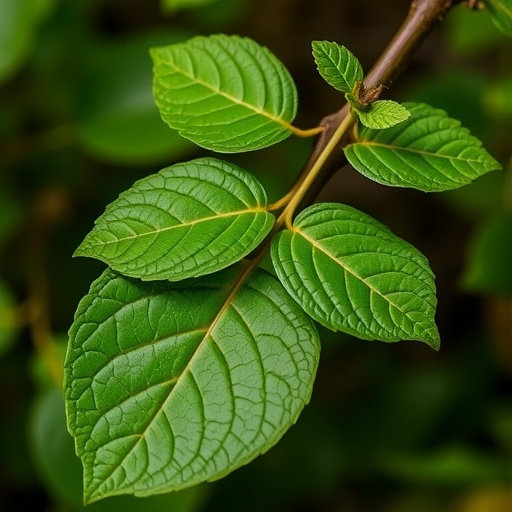In a groundbreaking study published in BMC Genomics, researchers have made significant strides in understanding the AP2/ERF gene family within the aromatic tree species known as Cinnamomum camphora. This genome-wide identification and characterization effort, spearheaded by a team of prominent scientists, has unveiled the complexities and potential functionalities of genes that have crucial roles in plant development, stress response, and metabolic processes. The research not only enhances our basic knowledge of gene families in plants but also holds potential implications for agricultural practices and biotechnology.
AP2/ERF transcription factors are critical regulatory proteins in plants, influencing a wide array of developmental processes as well as responses to environmental stimuli. The AP2/ERF gene family is known for its roles in the expression regulation of genes involved in responses to abiotic stresses like drought and salinity, as well as biotic stresses including pathogen attack. Characterizing this gene family in Cinnamomum camphora adds an important species to the existing database of plant genomic studies, which could lead to biotechnological applications aimed at improving crop resilience.
The identification process employed by the researchers involved comprehensive bioinformatics tools and methods to analyze the complete genome of Cinnamomum camphora. By executing a detailed annotation, the team meticulously categorized different members of the AP2/ERF family and elucidated their structures, including the conserved domains crucial for their functional activities. Advanced computational techniques were likely employed to align sequences, predict protein structures, and establish phylogenetic relationships amongst the identified transcription factors.
Moreover, the study is notable not just for the identification of genes, but also for the in-depth characterization of gene expression patterns. Gene expression profiling is essential in determining how these genes function under various conditions. By employing quantitative real-time polymerase chain reaction (qRT-PCR), the researchers assessed the expression levels of several AP2/ERF genes across different tissues and developmental stages of Cinnamomum camphora, providing insights into when and where these genes are activated within the plant’s lifecycle.
One of the study’s key findings is the identification of several novel AP2/ERF genes that may play roles specific to the metabolic pathways in Cinnamomum camphora, which is renowned for its essential oils and diverse bioactive compounds. This stretches the boundaries of traditional plant studies as the intersection between genomics and phytochemistry becomes more pronounced. By linking gene activity to the production of aromatic compounds, this study may pave the way for innovations in fragrance and flavor industries, potentially enhancing the economic value of Cinnamomum camphora.
The implications of this research extend far beyond Cinnamomum camphora alone. By enhancing the understanding of the AP2/ERF gene family, scientists can draw parallels and make predictions about the functionalities of similar genes in other economically important species, fostering advancements in crop breeding programs. The results could lead to the development of plants with enhanced resilience to climate change, resistance to pests, and optimization in the production of desired phytochemicals.
Importantly, this research highlights the advancements in genomic technologies that allow for swift and comprehensive exploration of plant genetics. The evolution of sequencing technologies, such as next-generation sequencing, has transformed the landscape of genomics, enabling researchers to generate vast datasets rapidly. Consequently, studies like this can accelerate our understanding of gene families across multiple species, some of which may have been previously understudied due to limitations in technology or funding.
Collaboration across disciplines is vital, and the team’s work exemplifies how genomics, bioinformatics, and molecular biology can converge to address complex biological questions. Understanding gene families at a genomic scale necessitates not just expert knowledge in plant biology, but also skilled proficiency in computational analysis and data interpretation. The collaborative nature of such research contributes to creating a well-rounded approach to studying biodiversity and gene functionalities.
Furthermore, the research contributes to conservation efforts for Cinnamomum camphora, which has been affected by habitat loss and over-exploitation. By understanding its genetic makeup and identifying key regulatory genes, conservationists and biotechnologists can devise strategies to preserve this valuable species while optimizing its cultivation for sustainable use, particularly in industries that benefit from its unique oil content.
Lastly, the implications of the novel findings on Cinnamomum camphora extend into the agricultural sector, opening doors for transgenic approaches that can enhance crops with desired traits. Employing techniques such as CRISPR/Cas9 gene editing to modify or activate specific AP2/ERF genes could lead to the creation of improved cultivars capable of withstanding environmental stressors or diseases. This aligns with the growing demand for sustainable agricultural practices aimed at ensuring food security in a rapidly changing world.
In conclusion, the research conducted on the AP2/ERF gene family in Cinnamomum camphora represents a significant advancement in plant genomics, providing valuable insights into the genetic underpinnings of essential traits. The findings have far-reaching implications, benefiting agriculture, conservation, and industry, and underscore the importance of continued research and innovation in plant genetics. Through collaborative efforts, scientists can deepen our understanding of plant biology and its relevance to global challenges.
Subject of Research: Genome-wide identification and characterization of the AP2/ERF gene family in Cinnamomum camphora.
Article Title: Genome-wide identification and characterization of the AP2/ERF gene family in Cinnamomum camphora.
Article References:
Yang, Z., Yang, X. & Zheng, X. Genome-wide identification and characterization of the AP2/ERF gene family in Cinnamomum camphora.
BMC Genomics 26, 972 (2025). https://doi.org/10.1186/s12864-025-12169-6
Image Credits: AI Generated
DOI: 10.1186/s12864-025-12169-6
Keywords: AP2/ERF gene family, Cinnamomum camphora, plant genomics, gene expression profiling, abiotic stress, biotic stress, bioinformatics, sustainable agriculture.
Tags: abiotic stress regulationagricultural biotechnology applicationsAP2/ERF gene familyaromatic tree species geneticsbioinformatics in genomicsbiotic stress resistanceCinnamomum camphora genomicscrop resilience biotechnologygenome-wide identification methodsplant developmental processesplant stress response genestranscription factors in plants





